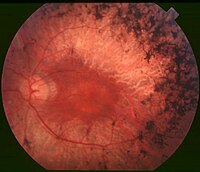
Photo from wikipedia
To describe clinical and genetic characteristics in a series of Chinese patients with non-syndromic retinitis pigmentosa, a total of 20 unrelated Chinese pedigrees with non-syndromic retinitis pigmentosa were evaluated. Complete… Click to show full abstract
To describe clinical and genetic characteristics in a series of Chinese patients with non-syndromic retinitis pigmentosa, a total of 20 unrelated Chinese pedigrees with non-syndromic retinitis pigmentosa were evaluated. Complete ophthalmic examinations data including the Humphrey visual field, spectral domain-optical coherence tomography, full-field electroretinography, and fundus fluorescence were collected and analyzed. Targeted exome sequencing was utilized to investigate variations in 260 known genes of inherited retinal disease, including the 90 known causative retinitis pigmentosa genes. We initially identified the potential candidate variants in the pedigrees, then validated the variants using the Sanger sequencing and performed segregation analysis to verify that the variants constituted disease-causing mutations in these pedigrees. We detected three novel (likely) pathogenic and eight previously reported (likely) pathogenic variations in nine genes reported to be related to non-syndromic retinitis pigmentosa in nine of the pedigrees. We report clinical characteristics of Chinese patients with retinitis pigmentosa and novel mutations responsible for non-syndromic retinitis pigmentosa in Chinese pedigrees, expanding the number of gene mutations associated with this disorder and clarifying its genetic basis in the Chinese population. These data will help with rapid and efficient molecular diagnosis and the study of targeted treatment for retinitis pigmentosa in this population.
Journal Title: Experimental Biology and Medicine
Year Published: 2022
Link to full text (if available)
Share on Social Media: Sign Up to like & get
recommendations!